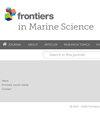黄鳍金枪鱼幼鱼红白肌肉的能量代谢比较
IF 3
2区 生物学
Q1 MARINE & FRESHWATER BIOLOGY
引用次数: 0
摘要
黄鳍金枪鱼(Thunnus albacares)的肌肉组织表现出明显的功能特化,缓慢收缩的氧化红色肌肉和快速收缩的糖酵解白色肌肉在能量代谢特征上表现出明显的差异。为了阐明这些功能差异背后的分子机制,本研究采用了一种综合方法,包括通过透射电子显微镜(TEM)进行超微结构分析、转录组分析和关键代谢调节因子的酶活性分析。透射电镜显示,与白色肌纤维相比,红色肌纤维含有更大的线粒体和突出的脂滴。我们的转录组分析发现了3162个显著表达差异的基因,其中1515个基因表达上调,1647个基因表达下调。功能富集分析表明,红色肌肉的DEGs与氧化磷酸化、三羧酸循环和脂肪酸β-氧化有显著关联,而白色肌肉则优先富集糖酵解/糖异生途径。酶学验证表明,红色肌肉表现出更高的柠檬酸合成酶活性(2.3倍)和β-羟酰基辅酶a脱氢酶水平(1.8倍),而白色肌肉表现出更高的己糖激酶活性(4.7倍)和乳酸脱氢酶活性(3.2倍)。这些发现为研究鲭鱼独特的游泳策略背后的生理适应提供了新的见解,揭示了与其持续巡航能力和突发游泳表现相对应的肌肉代谢途径的进化优化。本文章由计算机程序翻译,如有差异,请以英文原文为准。
Comparative energy metabolism in red and white muscles of juvenile yellowfin tuna, Thunnus albacore
The musculature of yellowfin tuna (Thunnus albacares ) exhibits distinct functional specialization, with slow-twitch oxidative red muscle and fast-twitch glycolytic white muscle demonstrating marked disparities in energy metabolic characteristics. To elucidate the molecular mechanisms underlying these functional divergences, this study implemented an integrated approach incorporating ultrastructural analysis via transmission electron microscopy (TEM), transcriptomic profiling, and enzymatic activity assays of key metabolic regulators. TEM imaging revealed that red muscle fibers contain larger mitochondria and prominent lipid droplets compared to white muscle fibers. Our transcriptome analysis identified 3,162 genes with significant expression differences-1,515 were up-regulated, and 1,647 were down-regulated. Functional enrichment analysis demonstrated significant association of red muscle DEGs with oxidative phosphorylation, tricarboxylic acid cycle, and fatty acid β-oxidation, while white muscle preferentially enriched glycolysis/gluconeogenesis pathways. Enzymatic validation revealed red muscle exhibited higher citrate synthase activity (2.3-fold) and elevated β-hydroxyacyl-CoA dehydrogenase levels (1.8-fold), whereas white muscle showed greater hexokinase activity (4.7-fold) and increased lactate dehydrogenase activity (3.2-fold). These findings provide novel insights into the physiological adaptations underlying the distinctive swimming strategies of scombroid fishes, revealing evolutionary optimization of muscle metabolic pathways corresponding to their sustained cruising capacity and burst swimming performance.
求助全文
通过发布文献求助,成功后即可免费获取论文全文。
去求助
来源期刊

Frontiers in Marine Science
Agricultural and Biological Sciences-Aquatic Science
CiteScore
5.10
自引率
16.20%
发文量
2443
审稿时长
14 weeks
期刊介绍:
Frontiers in Marine Science publishes rigorously peer-reviewed research that advances our understanding of all aspects of the environment, biology, ecosystem functioning and human interactions with the oceans. Field Chief Editor Carlos M. Duarte at King Abdullah University of Science and Technology Thuwal is supported by an outstanding Editorial Board of international researchers. This multidisciplinary open-access journal is at the forefront of disseminating and communicating scientific knowledge and impactful discoveries to researchers, academics, policy makers and the public worldwide.
With the human population predicted to reach 9 billion people by 2050, it is clear that traditional land resources will not suffice to meet the demand for food or energy, required to support high-quality livelihoods. As a result, the oceans are emerging as a source of untapped assets, with new innovative industries, such as aquaculture, marine biotechnology, marine energy and deep-sea mining growing rapidly under a new era characterized by rapid growth of a blue, ocean-based economy. The sustainability of the blue economy is closely dependent on our knowledge about how to mitigate the impacts of the multiple pressures on the ocean ecosystem associated with the increased scale and diversification of industry operations in the ocean and global human pressures on the environment. Therefore, Frontiers in Marine Science particularly welcomes the communication of research outcomes addressing ocean-based solutions for the emerging challenges, including improved forecasting and observational capacities, understanding biodiversity and ecosystem problems, locally and globally, effective management strategies to maintain ocean health, and an improved capacity to sustainably derive resources from the oceans.
 求助内容:
求助内容: 应助结果提醒方式:
应助结果提醒方式:


